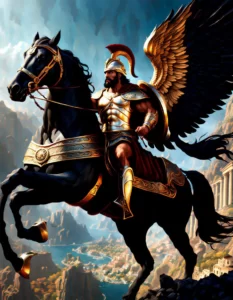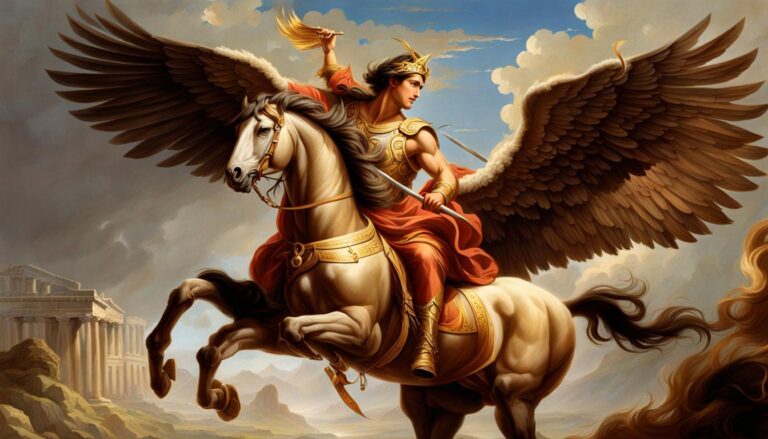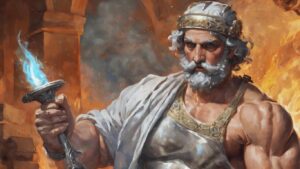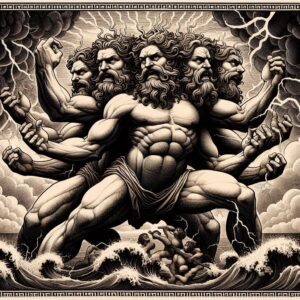Table of Contents
Fast Facts:
Pronunciation: buh-LAIR-uh-fon
Origin: Greek
Role:Hero
Symbols: Pegasus, Chimaera
Wife: Philonoe
Children: Isandros, Hippolokhos, Laodameia, Deidameia
In the tapestry of Greek mythology, the figure of Bellerophon stands out as a hero whose tale is interwoven with legendary creatures and extraordinary feats. Bellerophon, often celebrated for his daring exploits and courage, is perhaps best known for his alliance with the majestic winged horse, Pegasus. This article will delve into the captivating story of Bellerophon and explore the various facets of his mythical journey.
The Origins of Bellerophon
Bellerophon, the son of the mortal Corinthian king Glaucus, was destined for greatness from birth. However, his journey to heroism was not without its trials. The gods, recognizing his potential, chose to intervene in his life, setting in motion a series of events that would define his legacy.
The Winged Steed – Pegasus
At the heart of Bellerophon’s saga is the magnificent Pegasus, a winged horse born from the blood of the Gorgon Medusa after her fateful encounter with the hero Perseus. Pegasus, with its ethereal wings and divine lineage, became Bellerophon’s steadfast companion, aiding him in his quest for glory.
The Chimera: A Formidable Foe
Bellerophon’s most renowned exploit was his daring encounter with the Chimera, a fire-breathing monster with the head of a lion, the body of a goat, and the tail of a serpent. Tasked with defeating this formidable creature, Bellerophon relied on the courage bestowed upon him by the gods and the formidable abilities of his winged companion.
The Hubris of Bellerophon
Despite his heroic triumphs, Bellerophon’s story takes a tragic turn. Fueled by pride and arrogance, he sought to ascend to the heavens atop Pegasus, attempting to reach Mount Olympus itself. The gods, angered by his audacity, intervened, causing Bellerophon to fall from the skies and live out the remainder of his days in solitude and misery.
Bellerophon appearance

In the realm of Greek mythology, Bellerophon is often depicted as a figure of noble stature and strength, embodying the qualities of a hero. While specific descriptions of his appearance may vary across different interpretations, certain characteristics remain consistent in artistic and literary representations.
Physique and Demeanor: Bellerophon is typically portrayed as a well-built and physically imposing figure, reflecting his heroic nature. His demeanor is that of a courageous and determined warrior, with a presence that commands respect. Artists often depict him with a regal bearing, emphasizing his royal lineage as the son of Poseidon and Eurynome.
Armor and Attire: As a hero engaged in epic quests and battles, Bellerophon is commonly depicted wearing armor befitting a warrior. This may include a helmet, breastplate, and greaves, showcasing both his readiness for combat and his status as a formidable protector. The attire is often adorned with intricate details, reflecting the craftsmanship of divine or mortal artisans.
Weaponry: Bellerophon is frequently shown wielding a spear or a sword, weapons that highlight his martial prowess. The choice of weaponry symbolizes his readiness for the challenges he faces, particularly in battles against mythical creatures such as the Chimera.
Connection with Pegasus: In many depictions, Bellerophon is accompanied by Pegasus, the winged horse. The bond between the hero and his celestial steed is often emphasized, with both figures complementing each other in grace and strength. Bellerophon may be shown riding Pegasus or standing alongside the majestic creature, underlining the extraordinary alliance between mortal and mythical being.
Facial Features: While specific details about Bellerophon’s facial features may vary, he is commonly depicted with a visage that conveys determination and resolve. His eyes, often intense and focused, reflect the hero’s unwavering commitment to his quests.
Symbolism and Iconography: Bellerophon’s appearance may incorporate symbolic elements that represent his divine lineage and heroic achievements. These can include emblems associated with Poseidon or other symbols denoting his prowess in overcoming mythical challenges.
Bellerophon’s appearance in art and literature reflects the archetype of a heroic figure—a warrior endowed with strength, courage, and a connection to both the mortal and divine realms. The visual representations of Bellerophon contribute to the enduring allure of his myth and the timeless themes of Greek mythology.
Legacy and Symbolism
Bellerophon’s tale serves as a cautionary myth, warning against the dangers of hubris and the consequences of defying the will of the gods. His legacy endures in both literature and art, a testament to the enduring power of mythical storytelling.
Bellerophon Family

Parents: Bellerophon is often considered the son of the sea god Poseidon and the mortal woman Eurynome. However, in some versions, Glaucus and Eurymede are mentioned as his parents.
Upbringing: Glaucus, if considered Bellerophon’s father, raises him as his own son, believing him to be his biological child.
Marriage: Bellerophon is typically associated with either Anteia or Anticleia as his wife, not Philonoe.
Children: The names Hippolokhos, Isandros, Deidameia, and Laodameia are not commonly associated with Bellerophon in traditional Greek mythology. The number and names of his children may vary in different accounts.
Accomplishments: Bellerophon is best known for taming the winged horse Pegasus and for his heroic deeds, including the slaying of the Chimera and the defeat of the Solymoi.
Fate/Punishment: Bellerophon’s story usually involves a tragic turn after he tries to ascend to Mount Olympus on Pegasus. In some versions, he attempts to fly to the realm of the gods, which angers Zeus. As a punishment, Zeus sends a gadfly to sting Pegasus, causing Bellerophon to fall back to Earth. Bellerophon survives but is left crippled and isolated. The specifics of his lonely death may vary in different versions.
The story of Bellerophon and Pegasus continues to captivate audiences, offering a glimpse into the intricate tapestry of Greek mythology. As we unravel the layers of his journey, we are reminded of the timeless themes of heroism, hubris, and the enduring bond between mortals and the divine. Bellerophon’s legacy lives on as a testament to the enduring power of myth and the indomitable spirit of those who dare to challenge the gods.
Which famous monster is killed by Bellerophon?
Bellerophon is famous for killing the Chimera, a mythical monster with a composite body consisting of a lion, goat, and serpent parts.




